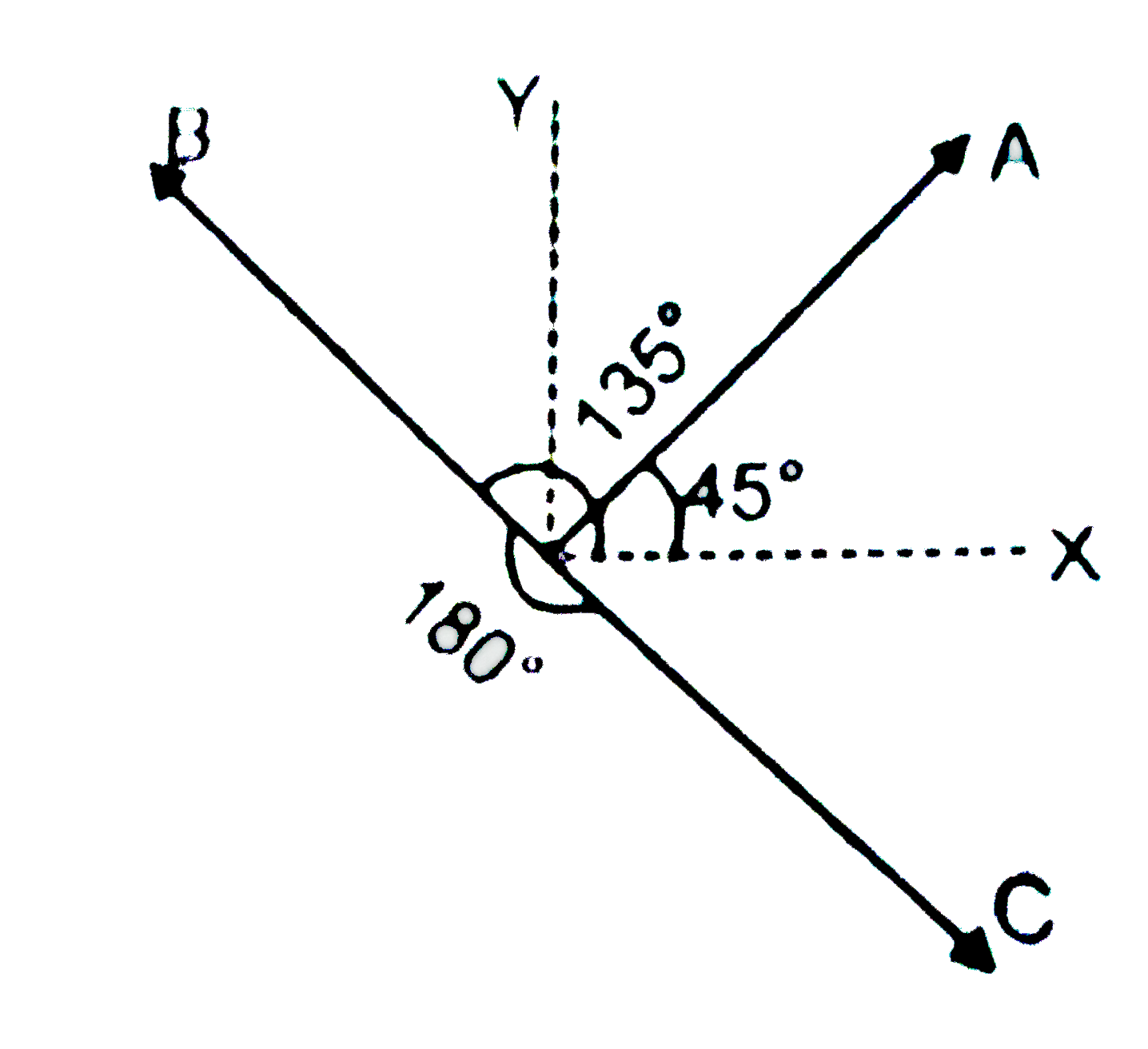Add vectors →A,→Band→C each having magnitude of 100 unit and inclined to the X-axis at angles 45∘,135∘and315∘ respectively.
The correct Answer is:100 unit at 45∘ with x axis
To solve the problem of adding the vectors →A, →B, and →C with magnitudes of 100 units and angles of 45∘, 135∘, and 315∘ respectively, we can follow these steps:
Step 1: Break down each vector into its components
We will use the formula for the components of a vector:
→V=Vx^i+Vy^j
where Vx=Vcos(θ) and Vy=Vsin(θ).
1. For →A:
- Magnitude = 100 units, Angle = 45∘
Ax=100cos(45∘)=100×√22=50√2
Ay=100sin(45∘)=100×√22=50√2
Thus, →A=50√2^i+50√2^j.
2. For →B:
- Magnitude = 100 units, Angle = 135∘
Bx=100cos(135∘)=100×−√22=−50√2
By=100sin(135∘)=100×√22=50√2
Thus, →B=−50√2^i+50√2^j.
3. For →C:
- Magnitude = 100 units, Angle = 315∘
Cx=100cos(315∘)=100×√22=50√2
Cy=100sin(315∘)=100×−√22=−50√2
Thus, →C=50√2^i−50√2^j.
Step 2: Sum the components of the vectors
Now, we will add the components of the vectors:
- Sum of x-components:
Rx=Ax+Bx+Cx=(50√2)+(−50√2)+(50√2)=50√2
- Sum of y-components:
Ry=Ay+By+Cy=(50√2)+(50√2)+(−50√2)=50√2
Step 3: Resultant vector
The resultant vector →R can be expressed as:
→R=Rx^i+Ry^j=50√2^i+50√2^j
Step 4: Magnitude of the resultant vector
To find the magnitude of the resultant vector:
|→R|=√R2x+R2y=√(50√2)2+(50√2)2=√2500×2+2500×2=√5000=100√5
Conclusion
The resultant vector →R has a magnitude of 100√5 units, and it is directed at an angle θ with respect to the x-axis given by:
tan(θ)=RyRx=50√250√2=1⟹θ=45∘
Final Result
Thus, the resultant vector has a magnitude of 100√5 units and is directed at an angle of 45∘ with respect to the x-axis.
---
We will use the formula for the components of a vector:
→V=Vx^i+Vy^j
where Vx=Vcos(θ) and Vy=Vsin(θ).
- Magnitude = 100 units, Angle = 45∘
Ax=100cos(45∘)=100×√22=50√2
Ay=100sin(45∘)=100×√22=50√2
Thus, →A=50√2^i+50√2^j.
- Magnitude = 100 units, Angle = 135∘
Bx=100cos(135∘)=100×−√22=−50√2
By=100sin(135∘)=100×√22=50√2
Thus, →B=−50√2^i+50√2^j.
- Magnitude = 100 units, Angle = 315∘
Cx=100cos(315∘)=100×√22=50√2
Cy=100sin(315∘)=100×−√22=−50√2
Thus, →C=50√2^i−50√2^j.
Now, we will add the components of the vectors:
Rx=Ax+Bx+Cx=(50√2)+(−50√2)+(50√2)=50√2
Ry=Ay+By+Cy=(50√2)+(50√2)+(−50√2)=50√2
The resultant vector →R can be expressed as:
→R=Rx^i+Ry^j=50√2^i+50√2^j
To find the magnitude of the resultant vector:
|→R|=√R2x+R2y=√(50√2)2+(50√2)2=√2500×2+2500×2=√5000=100√5
The resultant vector →R has a magnitude of 100√5 units, and it is directed at an angle θ with respect to the x-axis given by:
tan(θ)=RyRx=50√250√2=1⟹θ=45∘
Thus, the resultant vector has a magnitude of 100√5 units and is directed at an angle of 45∘ with respect to the x-axis.
Topper's Solved these Questions
- PHYSICS AND MATHEMATICSBook:HC VERMA ENGLISHChapter:PHYSICS AND MATHEMATICSExercise:Question for short Answer
Explore 14 Videos
- PHYSICS AND MATHEMATICSBook:HC VERMA ENGLISHChapter:PHYSICS AND MATHEMATICSExercise:Objective 2
Explore 5 Videos
- NEWTON'S LAWS OF MOTIONBook:HC VERMA ENGLISHChapter:NEWTON'S LAWS OF MOTIONExercise:Questions for short Answer
Explore 17 Videos
- REST AND MOTION : KINEMATICSBook:HC VERMA ENGLISHChapter:REST AND MOTION : KINEMATICSExercise:Question for short Answer
Explore 13 Videos
Similar Questions
Add vectors →A,→B and →C which have equal magnitude s of 50 unit and are inclined at angles of 45∘,135∘ and 315∘ respectively from x-axos.

View SolutionAdd vectors →A,→B and →C which have equal magnitude s of 50 unit and are inclined at angles of 45∘,135∘ and 315∘ respectively from x-axos.

View Solution
Knowledge Check
A magnitude of vector →A,→B and →C are respectively 12,5 and 13 units and →A+→B=→C then the angle between →A and →B is
A0Bπ/2Cπ/4Dπ
Let →Aand→B be the two vectors of magnitude 10 unit each. If they are inclined to the X-axis at angles 30∘and60∘ respectively, find the resultant.
View SolutionLet →Aand→B be the two vectors of magnitude 10 unit each. If they are inclined to the X-axis at angles 30∘and60∘ respectively, find the resultant.
View SolutionIf →aand→b are unit vectors inclined to x-axis at angle 30∘and120∘ then ∣∣→a+→b∣∣ equals
View SolutionThree vectors →A,→B and →C are such that →A=→B+→C and their magnitudes are in ratio 5:4:3 respectively. Find angle between vector →A and →C
View SolutionThree vectors →A,→B and →C are such that →A=→B+→C and their magnitudes are in ratio 5:4:3 respectively. Find angle between vector →A and →B
View SolutionIf →aand→b are two vectors of magnitude 1 inclined at 120∘, then find the angle between →band→b−→a.
View SolutionTwo vectors →A and →B have magnitude in the ratio 1:2 respectively. Their difference vector has as magnitude of 10 units, and the angle between →A&→B is 120∘ . The magnitude of →Aand→B are :
View Solution

